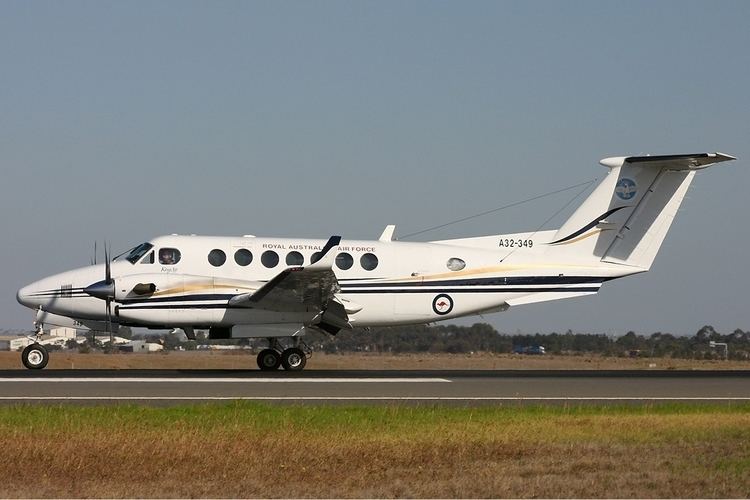Part of Air Training Wing Motto(s) Adaptable | ||
 | ||
Active February 1942 – November 1945July 1989 – current Role Training and light transport | ||
No. 32 Squadron is a Royal Australian Air Force unit based at RAAF East Sale in Victoria. It currently flies training and transport operations.
Contents
World War II
The squadron was established as a reconnaissance and bomber unit, equipped with Lockheed Hudson aircraft, at Port Moresby on 21 February 1942. It was formed from elements of other RAAF Hudson squadrons deployed from their home bases for combat operations against Japanese forces. No. 32 Squadron played an important role during the early stages of the New Guinea campaign, conducting anti-submarine and anti-shipping patrols, flying bombing sorties against enemy airfields and flying boat bases, as well as conducting reconnaissance and supply missions.
No. 32 Squadron's first mission took place the day it was formed, when aircraft were launched to search for a reported enemy submarine. A few days later, the squadron undertook the first of many bombing raids on the Japanese air base at Gasmata. After only a few weeks of operations, due to enemy raids on Port Moresby's Seven Mile airfield, the squadron was withdrawn to Horn Island, Queensland, but continued to stage out of Seven Mile on its missions, its aircraft refuelling there en route to their targets. In March 1942, one of the squadron's Hudsons was the first to spot the Japanese convoy transporting the forces for the invasion of the New Guinea mainland. Later the same month, the squadron engaged Japanese forces landing at Lae and Salamaua. In July 1942, No. 32 Squadron was active in the Gona area and during the lead-up to the Battle of Milne Bay.
The skill and fighting spirit of a lone, outnumbered crew from No. 32 Squadron impressed Saburō Sakai, who would become among the highest-scoring Japanese aces of the war. Pilot Officer Warren Cowan, Pilot Officer David Taylor, Sergeant Russell Polack and Sergeant Lauri Sheard, in Hudson Mk IIIA A16–201 (bu. no. 41-36979), were killed in action after being shot down by Sakai on 22 July 1942. A16–201 was intercepted over Buna, New Guinea by nine Mitsubishi A6M "Zeroes" of the Tainan Kaigun Kōkūtai, led by Sakai. The Hudson's crew surprised the Zero pilots by taking the initiative in a turning dogfight and were apparently unscathed for at least 10 minutes. Sakai observed that after he killed or wounded the Hudson's rear/upper gunner, the pilot became less able to evade his rounds. It caught fire and crashed in jungle near the coastal village of Popogo. So impressed were the Japanese pilots by their opponents that, many years after the war's end, Sakai asked Australian researchers to help him identify the pilot. In 1997, Sakai took the unusual step of writing to the Australian government, recommending that Cowan be "posthumously awarded your country's highest military decoration". The suggestion was rejected on the grounds that all such recommendations had been closed at the war's end, 52 years earlier.
Redeployed to Sydney in September 1942, No. 32 Squadron conducted anti-submarine patrols, initially from RAAF Base Richmond and then from Camden. In March 1943, the Hudsons were replaced by DAP-built versions of the Bristol Beaufort, which it used until the end of the war. The squadron was disbanded in November 1945.
Reactivation
No. 32 Squadron was reformed on 1 July 1989 at RAAF Base East Sale as a training and transport squadron equipped with Hawker Siddeley HS 748 aircraft. In 1997, leased Beechcraft B200 Super King Airs joined the squadron, although it continued to operate some of the HS 748s as well. No. 32 Squadron was re-equipped with leased Beechcraft King Air 350 aircraft commencing in 2003 and the remaining HS 748s were retired on 30 June 2004. There are eight King Air 350s in service.
The King Air 350s have been heavily modified and are used in three main roles: for Air Combat Officer and Maritime Aviation Warfare Officer; for low-level tactical and maritime operations training under the auspices of the School of Aviation Warfare; and as light transport aircraft. Typical low-level training missions are conducted at 200 to 500 feet (61 to 153 metres) above sea or ground level, while transport missions may be undertaken at altitudes as high as 35,000 ft (10,675 m). The current squadron motif is a sulphur-crested cockatoo with the Southern Cross depicted on a blue background.
